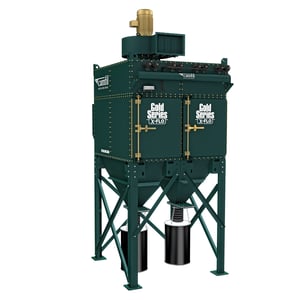Manufacturing, processing and packing of food and beverage products and their ingredients usually generates dust. This, in turn, can create a number of significant challenges for the industry.
When dust particles become airborne they can threaten employee health, contaminate products or cause combustible dust incidents. Using a proper designed and maintained dust collection system help to reduce those risks and keep your facility in compliance with local HSE regulations.
Within the food & beverage industry the composition of dusts varies depending on the finish product. It is crucial to understand your application and the processed ingredients, to determine the best performing extraction solution and to protect your production environment.
Handled ingredients: Coarse grains, fine spices, additives, flour, starch, sugar, cocoa flavourings and many more
Typical applications: Silo-venting, bulk handling, sack-tipping, weighing, mixing, blending, granulating, conveying, packaging etc.
If you are uncertain or don´t have all the relevant data, it´s recommended to evaluate the properties of the processed material. Besides analysing the dust characteristic, it also makes sense to perform a dust hazard analysis to evaluate the risk for employee exposure and a dust explosion & flammability test, which can be required according to ATEX-directives.
The major challenges for manufacturers in the food and beverage industry are:

Air filtration or dust extraction? It is not an either-or decision, it really depends on the concentration and on the properties of the dust. As a simple rule of thumb you can say, if the concentration is at or above 0.05 mg/m³, a dust collection system with pulse-cleaned filter elements will probably the best option to handle the process dust, providing a reasonable filter life.
One of the most important things is to design a properly working capture solution which captures the dust directly at the source. Through ductwork the emissions are led into a dust collector and through the filter elements, where airborne particles are separated from the air stream. The filters get cleaned by a pulse of compressed air and the dust particles are discharged downwards into a hopper. The cleaned air is extracted by a fan, led through an optional HEPA filter stage, before it is returned to the production or exhausted to atmosphere.

What you should take into consideration to determine the right extraction solutions for your application:
Capture point, type of dust, temperature, air volume, combustion or explosion risks, operating hours, filter media.
Safety needs to be based on several legs, each one equally important:
Good system design, basically safe
Dust collectors are critical in helping you keep your facility safe and compliant. They are necessary safety systems but if they are not designed, installed and maintained properly, these systems themselves can cause serious problems.
Explosion protection
The ATEX-directive requires that the employer is responsible to carry out a risk assessment to determine the necessary fire and explosion protection.Furthermore all ATEX safety systems require regular inspection and service to function reliably.
Exposure limits
Food manufacturers are required to protect workers from exposure (each manufacturing application will have its own unique set of process conditions). Companies must control dust emissions into the indoor workplace atmosphere to comply with legal limits set for a particular material. If no legal limits are applicable, then the company is required to define in writing, implement and measure its own environmental safety plan.
Training & work routines
At least a basic training for all users recommended, they shall understand the purpose of the explosion protection systems and the remaining risks, the need of renewal the risk assessment in case of process changes or what to do in a case of emergency.
Health, safety and environment
HSE regulations vary locally and it is the employers task to be up-to-date and compliant with this requirments in order to protect the operators, the products and the environment from harmful emissions. All dust collection systems should be inspected anually by a qualified service engineer.

